Five desserts that are actually good for your gut
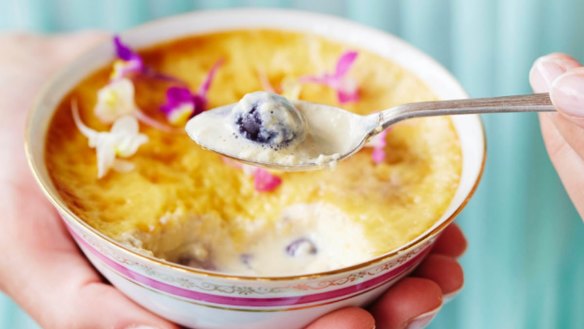
Craving the sweet stuff but constantly at war with your gut? Forget fighting the urge to indulge, you can still treat yourself without ditching dessert, it's all down to knowing your friends from your foe.
Labels such as raw, vegan, sugar-free and 'dairy-free now crowding the dessert aisle, but with this abundance of 'healthy' choices, do we really what is good for us and how much is too much? Latest statistics suggest probably not.
Currently we're consuming more sugar than ever before (refined white or otherwise), with one in two Australians having more than the recommended guidelines, according to the Australian Bureau of Statistics.

Not only is this a blow to our waistlines and a major source of digestive discomfort, the level of sugar and fats we're consuming is also having a direct affect on our brains too. A new University of Oregon study found diets high in fat and sugar can directly cause changes in our gut bacteria that contribute to a loss of cognitive flexibility, impaired early learning, long term and short term memory issues and an inability to adapt to changing situations.
But the good news is, you can still have your cake and eat it too! Lee Holmes, Sydney nutritionist behind Supercharged Food and author of the Heal Your Gut cookbook says it's all a matter of learning good versus bad and the difference between a little and a lot.
"Often it's not a matter of blaming sugar it's the combination of sugar and additives such as guar gum or carrageenan (ingredients used to stabilise, emulsify and thicken foods)," says Holmes.
That's not to say sugar isn't at the heart of health concerns either. "Too much sugar can affect our brain function and mood, weight gain, diabetes, metabolic issues and overload the liver, which then leads to a myriad of other diseases," says Holmes.

What healthier alternatives should we be sticking with instead? Holmes recommends manuka honey or stevia. "Normal honey is often poorly regulated and can contain corn syrup, artificial sweeteners and not much actual honey. Manuka is derived from the Manuka tree in New Zealand and is gut-friendly, great for boosting our immune system, soothing a sore throat and aiding in allergies."
For a healthy amount, Holmes recommends one to two teaspoons of Manuka per serving. Or alternatively, try stevia: "It's low in calories, doesn't affect blood sugar levels in the body and unlike white sugar, stevia is safe for people who have diabetes, pregnant women and even children."
Sweeteners aside, Holmes recommends watching our dairy and gluten intake too. "Too much gluten can cause bloating, inflammation in the gut and make us vulnerable to immune diseases, while too much dairy can result in inflammation, poor skin, make us feel phlegmy and wreak havoc on our digestion," explains Holmes.
Pete Evans, celebrity chef and author of The Complete Gut Health Cookbook recommends choosing good fats as a primary dessert ingredient.
"Opt for non-dairy fats such as coconut, avocado, eggs, nuts, seeds and gelatine and if you can add in probiotic rich foods like kombucha or dairy free kefir and coconut yoghurt even better," Evans says.
However, before you go nuts on a raw cheesecake, bare in mind that 'good fats' are only good in moderation.
"Raw desserts are still desserts. Store-bought varieties can contain more sugar than standard snack bars and often have a high number of nuts in them," says Holmes. "While a handful is great, if you're eating a nut-packed raw dessert for breakfast, lunch and dinner it can lead to weight gain, irritability and constipation."
"I suggest a handful (ten to fifteen nuts a day) depending on the type of nut you're consuming. Macadamia nuts are delicious but one has enough fat for a whole day. Almonds, walnuts, pecans and cashews are lower fat," says Holmes.
Want to opt for gut loving groceries from the get go? "Try quinoa or oats instead of white flour. Oats are great for digestion, relief in irritable bowel disease and constipation and can improve our overall cholesterol levels," says Holmes.
"Also try seed butters like tahini - it has more protein than milk and contains vitamins B and E (important for brain and heart function). Alternatively if you're not a fan of tahini, pumpkin seed butter is high in copper, protein and zinc (all good for heart health) and sunflower seed butter has calcium and selenium (great for strong bones!)."
For the recipes below, opt for powdered grass-fed gelatine (available at select health food stores) rather than commercial cooking gelatine.
Five healthy desserts your stomach will love
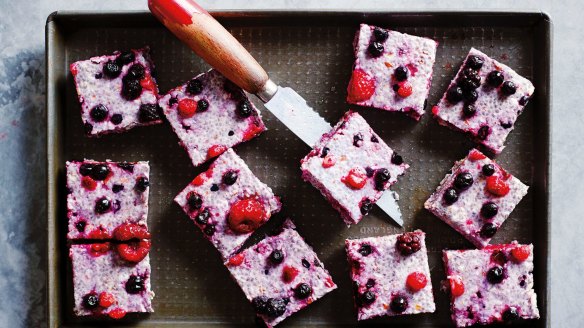
1. Nic's chia slab
"This is a family favourite and contains grass fed gelatine which is great for the gut," says Evans.
2 tbsp powdered grass-fed gelatine
800ml coconut cream
200g chia seeds
Zest of 1/2 lemon
400g mixed fresh or frozen berries
1. Grease a 20cm x 30cm baking tin and line the base and sides with baking paper.
2. Place the gelatine in a small bowl. Add four tablespoons of water and set aside for five minutes to allow the gelatine granules to soften and expand.
3. Heat the coconut cream in a saucepan over medium heat until just starting to simmer. Remove from the heat, add the gelatine mixture and stir until the gelatine has dissolved.
4. Pour the warm coconut cream mixture into a bowl, sprinkle on the chia seeds, a little at a time and mix through. Fold in the lemon zest and half the mixed berries and pour into the prepared tin. Smooth the top with a spatula, then sprinkle on the remaining berries. Cover with plastic wrap and place in the fridge to set for four hours.
5. When the chia slab is firm, remove from the tin and cut into 5cm squares. Place on a platter and serve. Store leftovers in an airtight container in the fridge for one week.
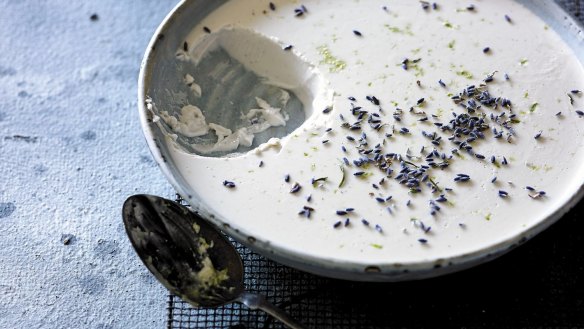
2. Lavender panna cotta
"Helen's panna cotta has the gentle gut healthy lavender added to it as well as grass fed gelatine," says Evans.
450ml coconut cream
90g (1/4 cup) honey (manuka)
1/2 vanilla pod, split lengthways and seeds scraped
2 1/2 tbsp dried edible lavender, plus extra to serve
finely grated zest of 1/2 lime, plus extra to serve
1 1/2 tsp powdered gelatine
1. Combine coconut cream, honey, vanilla pod and seeds, lavender and lime zest in a saucepan over medium heat. Bring to the boil, stirring to dissolve the honey. Remove from the heat, cover and set aside for 1 hour to allow the flavours to infuse.
2. Pour 2 tablespoons of water into a small cup, sprinkle in the gelatine and set aside for 5 minutes.
3. Place the coconut cream mixture over low heat and bring to just a simmer. Remove from the heat, pour in the gelatine mixture and whisk until the gelatine dissolves. Strain and cool to room temperature.
4. Pour the cooled panna cotta into a serving dish. Place in the refrigerator to set for 4 hours, or until firm with a slight wobble. Sprinkle over some extra lavender and lime zest to decorate.
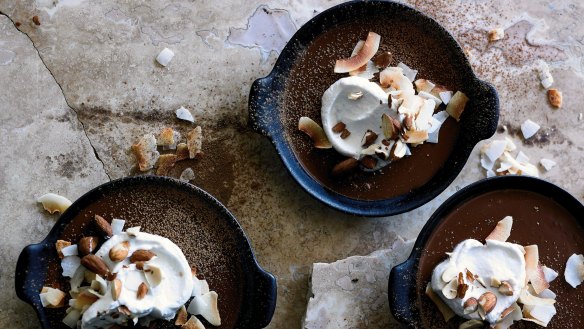
3.Chocolate pudding
"These chocolate puddings are a crowd favourite and full of good, healthy fats," Evans says.
1 tbsp powdered grass-fed gelatine
400ml coconut milk
50g (scant 1/2 cup) raw cacao powder, plus extra for dusting
1/4 tsp ground cinnamon
3 tbsp Manuka honey
150g whipped coconut cream
toasted coconut chips and crushed hazelnuts, to serve
1. Mix the gelatine with three tablespoons of water in a small bowl and set aside for five minutes to allow the gelatine granules to expand and soften.
2. Place the coconut milk, cacao powder, cinnamon and honey or maple syrup in a saucepan over medium heat and whisk to combine. Bring to just below simmering point and remove from the heat.
3. Add the gelatine mixture to the warm coconut milk mixture and stir until the gelatine dissolves. Transfer to four 150ml ramekins and place in the fridge for one hour to set (or freezer for 20 minutes for faster setting).
4. To serve, spoon over some whipped coconut cream, sprinkle on toasted coconut chips and hazelnuts and finish with a dusting of extra cacao.
Recipes from The Complete Gut Health Cookbook' by Pete Evans, published by Plum, RRP $39.99.

4. Baked blueberry custards
"This is one of my favourite sweet comfort foods to cuddle up to at the end of a cold day. Coconut milk is an excellent replacement for dairy, making it an allergy and digestive system friendly custard," says Holmes.
400ml tin additive-free coconut milk
4 organic egg yolks
1 tsp alcohol-free vanilla extract
8 drops liquid stevia
155g blueberries
1. Preheat the oven to 140C.
2. Heat the coconut milk in a saucepan over medium heat for two to three minutes or until warmed.
3. Meanwhile, whisk egg yolks to ribbon stage (when you lift the whisk the mixture falls slowly and forms a ribbon that holds its shape for a while). Slowly add the coconut milk to the egg, then return to the saucepan and place over medium heat, stirring constantly until it starts to thicken. Remove from the heat, then stir through the vanilla extract and stevia.
4. Divide the blueberries between four ramekins or ovenproof bowls, then pour the egg mixture over the top.
5. Place the serving dishes in a baking dish, then pour enough boiling water into the baking dish to come halfway up the sides of the ramekins.
6. Bake for 30–35 minutes or until the custards wobble when shaken gently. Allow to cool, then refrigerate until you're ready to serve.
Serves four
Recipe from Lee Holmes' Heal Your Gut cookbook, published by Murdoch Books and available from Supercharged Food
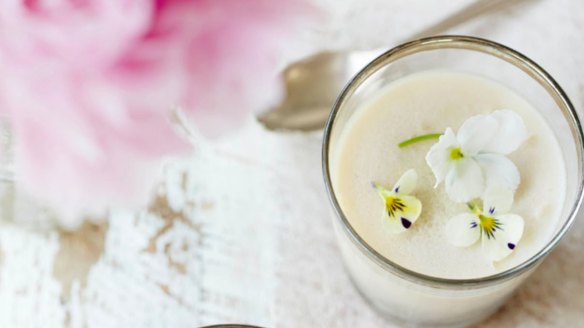
5. Almond milk jelly cup
"Gelatine is a good source of protein and contains eighteen protein-building amino acids. It's a great ingredient to include in your gut-healing arsenal as it seals the digestive tract which helps boost nutrient absorption," Holmes says.
250ml almond milk
2 tsp powdered grass-fed gelatin
1/4 tsp vanilla powder
1/2 tsp powdered stevia
1. Put half the almond milk and gelatine in a small saucepan over low heat. Whisk briskly until the gelatine is dissolved.
2. Remove from heat and add remaining almond milk along with gut powder, vanilla and stevia and whisk to combine.
3. Pour into one or two glasses or jelly moulds and refrigerate until set. The jelly can be stored in an airtight container in the fridge for 1–2 weeks.
Makes 1 cup
Recipe from Lee Holmes' Heal Your Gut cookbook, published by Murdoch Books and available from Supercharged Food.
Appears in these collections
The best recipes from Australia's leading chefs straight to your inbox.
Sign up